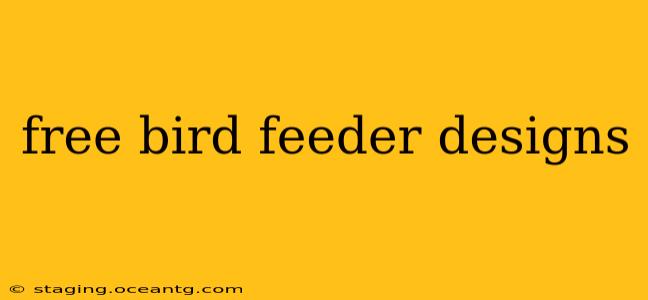Want to attract a vibrant array of birds to your backyard? Building your own bird feeder is a rewarding and cost-effective way to do just that! This guide explores several free bird feeder designs, offering various levels of complexity and materials, ensuring there's a perfect project for everyone, from beginner DIY enthusiasts to seasoned crafters. We'll delve into the specifics of each design, helping you choose the best option to suit your skills and resources.
What are the easiest bird feeder designs?
One of the easiest bird feeder designs to create uses readily available materials like a plastic bottle. Simply cut two holes on opposite sides, large enough for birds to access, but small enough to prevent larger seeds from spilling. Insert a stick or dowel through the holes to create perches. You can even decorate the bottle with paint or other embellishments. This method is especially great for children, providing a fun and educational activity. Another simple option involves using a pine cone coated in peanut butter and rolled in birdseed. This natural feeder is charming and simple to make.
How to make a bird feeder from recycled materials?
Sustainability and creativity go hand in hand! Many recycled materials can be transformed into unique and functional bird feeders. Milk cartons, yogurt containers, and even toilet paper rolls can all be repurposed. Clean and thoroughly dry your chosen container, then cut an access hole for the birds. Consider adding a roof for protection from the elements. You can enhance the design by adding perches and decorating the feeder with natural materials like twigs or colorful buttons. This not only saves you money but also reduces waste.
What are some more advanced DIY bird feeder designs?
For those seeking a more challenging project, consider crafting a bird feeder from wood. A simple platform feeder is a good starting point. Cut a square or rectangular piece of wood, add sides for stability, and attach a sturdy hanger. This design allows various types of birds to feed comfortably. For a more complex design, you might try building a suspended feeder with intricate details. Remember to use weather-resistant wood and ensure all parts are securely fastened to prevent the feeder from falling apart. A well-constructed wooden feeder can last for years, providing a beautiful and functional addition to your garden.
What kind of birdseed should I use in my homemade bird feeder?
The type of birdseed you choose will influence the types of birds that visit your feeder. Sunflower seeds are a popular choice, attracting a wide range of species. Nyjer seeds are ideal for attracting finches, while suet provides a high-energy option for birds during colder months. Consider offering a variety of seeds to attract diverse bird species. Always ensure the seeds are fresh and stored properly to prevent spoilage.
How do I keep squirrels away from my bird feeder?
Squirrels are notorious for raiding bird feeders! To deter these furry thieves, consider using feeders with squirrel-resistant features such as cages or baffles that prevent them from reaching the food. You can also try strategically placing your feeder out of reach or using a type of seed that squirrels generally dislike. Careful placement and feeder design can significantly reduce unwanted guests at your bird feeder.
Where is the best place to hang a bird feeder?
Placement is crucial for a successful bird feeder. Choose a location that offers protection from the elements, such as under a tree or overhanging branch. Ensure the feeder is accessible to birds but out of reach of cats and other predators. A spot near shrubs or trees provides a safe place for birds to land and take flight. Consider offering various feeding locations throughout your yard to accommodate a larger flock of birds.
By following these simple designs and tips, you can create beautiful and functional bird feeders that will attract a variety of birds to your backyard, all while enjoying the satisfaction of a DIY project. Remember to clean your feeders regularly to prevent the spread of disease and to ensure your feathered friends remain healthy and happy.
